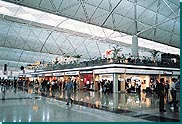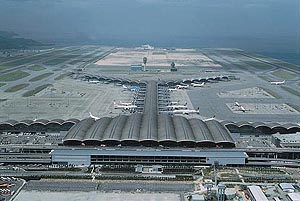| August
2000 |
 |
|
|
Hong Kong International Airport -
Development
continues after two years of operations
On the second anniversary of Hong
Kong International Airport, the Airport Authority (AA) has made
some reviews of its past performance and plans for the future development
of the airport.

In 1999, the airport was ranked number
five and number one worldwide in terms of international passenger
and cargo throughput respectively. It operates 24 hours a day and
can handle three million tons of cargo annually. Hong Kong has a
well-developed air route network, with direct air links operated
by over 60 airlines to some 130 destinations in more than 40 countries
worldwide.
While 58 per cent of
Hong Kong's air cargo is carried in the holds of passenger aircraft,
there has been a significant growth in all-cargo services. The number
of all-cargo aircraft movement at Hong Kong has more than doubled
in the past decade (15,264 in 1999 versus 7,173 in 1989). The number
of all-cargo carriers has increased almost two-fold from 15 in 1989
to 29 in 1999. For air cargo services, the government will continue
to explore expansion of air services links to meet market demand.
In the meantime, there are two air cargo franchisees at the airport.
The larger one operated by Hong Kong Air Cargo Terminals Ltd, SuperTerminal
1, is the world's largest stand-alone air cargo terminal handling
up to 2.6 million tons a year while the other franchisee, Asia Airfreight
Terminal, can handle 420,000 tons a year. In addition, there are
four courier companies providing air express services: DHL, Federal
Express, TNT and UPS.
Hong Kong is the most
important destination for trade between mainland China and the rest
of the world. The re-export of mainland-sourced goods through Hong
Kong accounted for 56 per cent of Hong Kong's total re-exports in
1999. In particular, some 80 per cent of the total value of imports
and exports of Guangdong Province are handled by the ports and airport
of Hong Kong. As for passenger traffic, there are a total of seven
airlines, including the Hong Kong-based Dragonair, providing scheduled
flights between Hong Kong and 40 cities in the mainland. The frequency
of flights has increased by 20 per cent in the last two years.
With China's imminent
entry to the World Trade Organisation, trade activities, air cargo
and passenger traffic between mainland China and the rest of the
world are expected to increase dramatically. To meet future demands,
the government and the AA have decided to build a marine cargo terminal
and two logistics centres at the airport. The marine cargo terminal
will provide an alternative and efficient means of transport of
air cargo in addition to the land route between the Pearl River
Delta and the airport. The logistics centres will enhance Hong Kong's
position as an important centre in the Asia Pacific distribution
network. They will allow local and overseas companies to provide
services ranging from sourcing and distribution to more value-added
services such as quality control and product testing. The government
and the AA also intend to implement a 15 per cent cut in aircraft
landing and parking charges so as to consolidate Hong Kong's position
as the premier aviation hub in the region. Furthermore, a HK$50
million (US$6.41 million) landscaping project will be launched to
plant two million trees and seedlings (such as bauhinias) to give
visitors a fresh, green look at the airport and a good first impression
of Hong Kong. the airport will also upgrade the nursery facilities
within the airport area, water fountains, toilets and smoking lounges.
The AA is also exploring new retail formats to cater the changing
needs of passengers. It is planning to have a Cyber Zone in the
northwest concourse featuring hi-tech facilities such as internet
services which are expected to be available in October.
The Airport Authority
has achieved and even exceeded performance targets. In the fourth
customer survey, an independent study conducted by Lingnan University
in January 2000, 91.8 per cent of respondents were "satisfied" or
"very satisfied" with the airport. Indeed, the customer satisfaction
rate has been staying at about 90 per cent.
|

